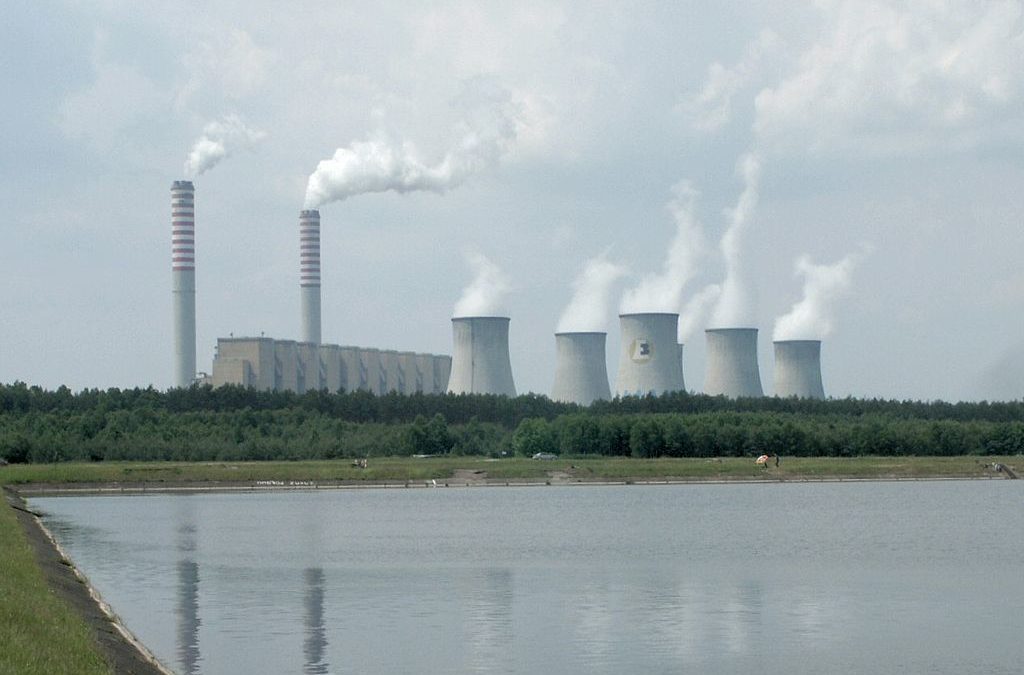By Karolina Baca-Pogrzelska (tekst dostępny również w języku polskim)
The drought that has been predicted to blight Poland this summer is again raising concerns over whether power suppliers will be able to cope. This time, however, the country’s energy infrastructure is better prepared to cope.
“Producers have not indicated that the current hydrological situation has had a significant impact on electrical energy production,” Beata Jarosz-Dziekanowska, spokesperson for the state-owned transmission system operator PSE, tells Notes from Poland. “The problem of low water levels in rivers concerns power stations with open-circuit cooling.”
As Jarosz-Dziekanowska explains, Poland has five such facilities: the old blocks of the Kozienice power stations as well as those in Połaniec, Ostrołęka, Dolna Odra and Stalowa Wola. Dolna Odra does not have such problems because it is located in the lower reaches of the river, where low water levels have not yet been recorded. Furthermore, in the Stalowa Wola power plant, a gas and steam block will shortly be launched, so the two old units with 125 MW cooled by the River San will no longer be so important.
Not counting the Dolna Odra blocks (6 x 200 MW) and Stalowa Wola, therefore, the total capacity of plants affected by river levels is around 3,550 MW. By way of comparison, the overall capacity of all conventional power stations in Poland is approximately 34,000 MW. Drought is therefore a problem for just over 10% of power.
This might seem a small amount, yet just five years ago, in summer 2015, it proved to be a genuine problem. So-called “level 20” of power rationing was introduced, almost unheard of since the communist period. What are power-rationing levels, and what makes number 20 the most famous?
Power rationing in Poland
Level 11 is the standard measure of power. Consumers can get the electricity specified in their contract, which in practice means unlimited usage. Levels 12 to 19 mean an even reduction of the power available. To all intents and purposes, the difference might not even be noticeable.
And then there is power-rationing level 20, meaning that consumers have access to electricity to a set minimum that does not pose a risk to safety or threaten to damage technological products. An example of what this means in practice, and many people remember from 2015, is much less lighting in hypermarkets and large stores.
As a result of the recurring problem of low water levels in rivers, owners of installations have been making investments allowing them to, for example, dam the water. This makes it possible to continue production even with low river levels.
This summer will also be the first year when the power installed in photovoltaics, i.e. producing energy from the sun, will be close to 2,000 MW. PSE’s data show that on 1 April 2020, Poland’s National Electroenergetic System had 1,695 MW of photovoltaic power. This is a year-on-year increase of more than 180%, and by the summer there will certainly be more new installations.
Photovoltaics is more “convenient” for the electroenergetic system, because electrical energy is produced when it is most needed, in the daytime. This is when temperatures are highest, and in summer air conditioning works at full capacity.
“We also have remedies that allow us to ease balance sheet problems, including contracted demand side response (DSR) services, which means reduction of energy use at the request of the transmission system operator,” explains Jarosz-Dziekanowska. “And finally, electrical energy import is available – international connections have been extended significantly since the disastrous 2015.”
PSE is legally obliged to determine the transmission capabilities in inter-system connections and make them available to market participants. The size of energy imports and exports to Poland is the result of market participants operating freely in the European electrical energy market, which became free and subject to competition rules well over a decade ago. Parallel rules apply in all EU countries.
Are the energy companies prepared for drought?
The recent torrential rain in many parts of Poland has not had a major impact on the hydrological situation. Real summer and real heatwaves are yet to come. We checked how the “big four” state-controlled energy companies in Poland are preparing for the predicted drought.
“Our hydroelectric power stations and conventional water-cooled blocks are prepared for the situation resulting from drought, since rivers could be affected by low water levels,” says Krzysztof Kopeć of the Gdańsk-based Energa Group. “In Ostrołęka, Energa has built a special weir on the Narew River damming water at the place of supply. So at present there is no threat to the operation of hydroelectric stations.”
The current water level on the Narew at the town of Ostrołęka does not inhibit the work of the conventional power station Ostrołęka B, which has a capacity of 690 MW (three blocks each of 230 MW cooled by water). The water level, which is constantly monitored, is about 30 cm higher than the warning level. The power station is prepared for low water levels as a result of the weir built by Energa, the first such solution in Poland.
“The power stations that belong to the Enea Group are prepared for working at lower water levels,” says Piotr Ludwiczak, spokesman for the Poznań-based company, continuing:
The hydrological situation is being constantly monitored, and the cooling installations are maintained at full readiness. In the Kozienice power station, the new energy block with a capacity of 1,075 MW is cooled using a so-called closed system with a cooling tower. So the impact of the temperature and river water level on the work of this plant is minimal. The class 200 and 500 MW blocks use open-circuit cooling, which in recent years has been modernised and is prepared for working at low water levels.
A temporary bar stabilising the water level has also been built in the river next to the power station. In addition, Ludwiczak explains, Kozienice is equipped with a system of ventilation coolers to cool down the water returning to the river in rising temperatures. Enea’s power station at Połaniec also uses open cooling, and Ludwiczak says it is prepared for the potential problems a drought might cause.
“One of the facilities is a flexible bar stabilising the river level, which guarantees the necessary flow of water to the cooling system, ” he explains. “Every year, the bar is subject to periodic reviews, keeping it fully ready. The power station can also employ additional cooling of the water returning to the river by using so-called hybrid-circuit pumps with sprinkling coolers.”
Tauron also says that it is prepared for a drought. Yet the question of open cooling at this company is the least of its problems, looking at its installed capacities.
“Over 90% of the cooling in our energy blocks uses closed-circuit systems, so they don’t collect water directly from rivers,” says company representative Łukasz Zimnoch. “In a closed circuit, cooling towers are used for cooling the refrigerant – the collected water is pumped through and cooled in a tower, before returning to the circuit in the power station.”
Only one of Tauron’s power stations, Stalowa Wola, uses open cooling. Zimnoch says that the parameters of the River San in the town are within the norm, at 146 cm, well above the 50 cm minimum water level needed.
The biggest of the national companies, PGE, is also monitoring water levels. In three power stations – including the largest, Bełchatów, Opole and Turów – the energy blocks operate with a closed-circuit cooling system, providing a guarantee of stable operation and uninterrupted supplies of electrical energy to consumers.
At Rybnik power station, two cooling systems (closed- and open-circuit) are employed, using water from a reservoir on the river, meaning that the flexibility and reliability of electrical energy production can be increased. This system allows the plant to produce energy in times of high temperatures and potential drought.
In the aforementioned Dolna Odra, meanwhile, only an open cooling system is used. In this case too, however, the reduced water level in rivers resulting from the drought does not affect the parameters of the work of the generating units. The plant’s position in the lower reaches of the river means that it is suited for working in the difficult hydrological conditions that may ensue in a drought.
According to PGE, the drought also does not endanger the operation of the power stations under the auspices of its daughter enterprise PGE Energia Ciepła, because even where cooling systems are open or semi-open, measures have been taken to guard against potential threats.
The dangers of drought
“In Poland we have several power stations and coal-fired power plants with open-circuit cooling, which take huge amounts of water from rivers or lakes and then have to let the water back out into them,” Bartłomiej Derski from the website Wysokienapiecie.pl tells us.
“The most important ones are Kozienice, which is the second-biggest power station in Poland, and out of 4 GW of installed capacity as much as 3 GW works in an open-circuit cooling system using the Vistula River.”
According to Derski, in installations with an open cooling system, a drought could hinder water consumption, contrary to the reassurances of power engineers. Yet most of them have already invested in systems such as water damming and pumps, meaning that water will be available even in a major drought.
However, as Derski explains, the second danger arises when the hot water is released at the end of this open circuit. Power stations have environmental permits entitling them to raise the temperature of water in a river or lake to a maximum of 35 degrees Celsius.
Low river levels coupled with prolonged very high temperatures can raise the temperature in the water body to a level forcing power stations to limit production to avoid exceeding the limit when releasing the water, resulting in environmental disaster and fines.
If a drought takes place without a heatwave, Derski predicts that restrictions on production should not be needed. But if the two phenomena coincide, production restrictions could reach approx. 2-3 GW, i.e. around 10% of the production capacity of coal-fired plants in Poland.
Wind power stations will not be helpful in this case because heatwaves in Poland are almost always accompanied by a high-pressure zone lying over Poland, so there is almost no wind.
Poland in a better position than five years ago
Since 2015, when restrictions were imposed on energy supply in Poland, the country has gained around 3 GW in coal blocks with a closed circuit of water, around 1 GW in gas power stations, and almost 2 GW already in solar-powered plants, which work to greater capacity precisely when the burden on the system is greatest.
Poland therefore now has much more capacity not dependent on hydrological conditions than it did in 2015, Derski confirms. Additionally, the average capacity at which it can import electrical energy from its neighbours has grown 1-2 GW, while PSE has contracted almost 0.8 GW capacity within the DSR programme.
Derski thinks that signs are good: “The energy situation in Poland seems in good shape, despite an expected increase in peak demand of around 2 GW compared to the situation five years ago, assuming that in the time of coronavirus we have heatwaves lasting many days and people return to office buildings and shopping centres.”
Derski adds that for the time being he does not expect limits on electricity supplies for industry. It is impossible to be certain, however, if a number of factors coincide: such as drought, a lengthy heatwave, problems with a transborder connection, overrunning planned power station renovations, a large number of problems in conventional plants or the need to limit energy transmission on some lines if they become overstretched, high air temperature, lack of wind and high insolation.
But all these problems happening at the same time really would be the darkest scenario for Polish energy.
Translated by Ben Koschalka
Main image credit: Wikimedia/Pibwl (under CC BY-SA 3.0)





















